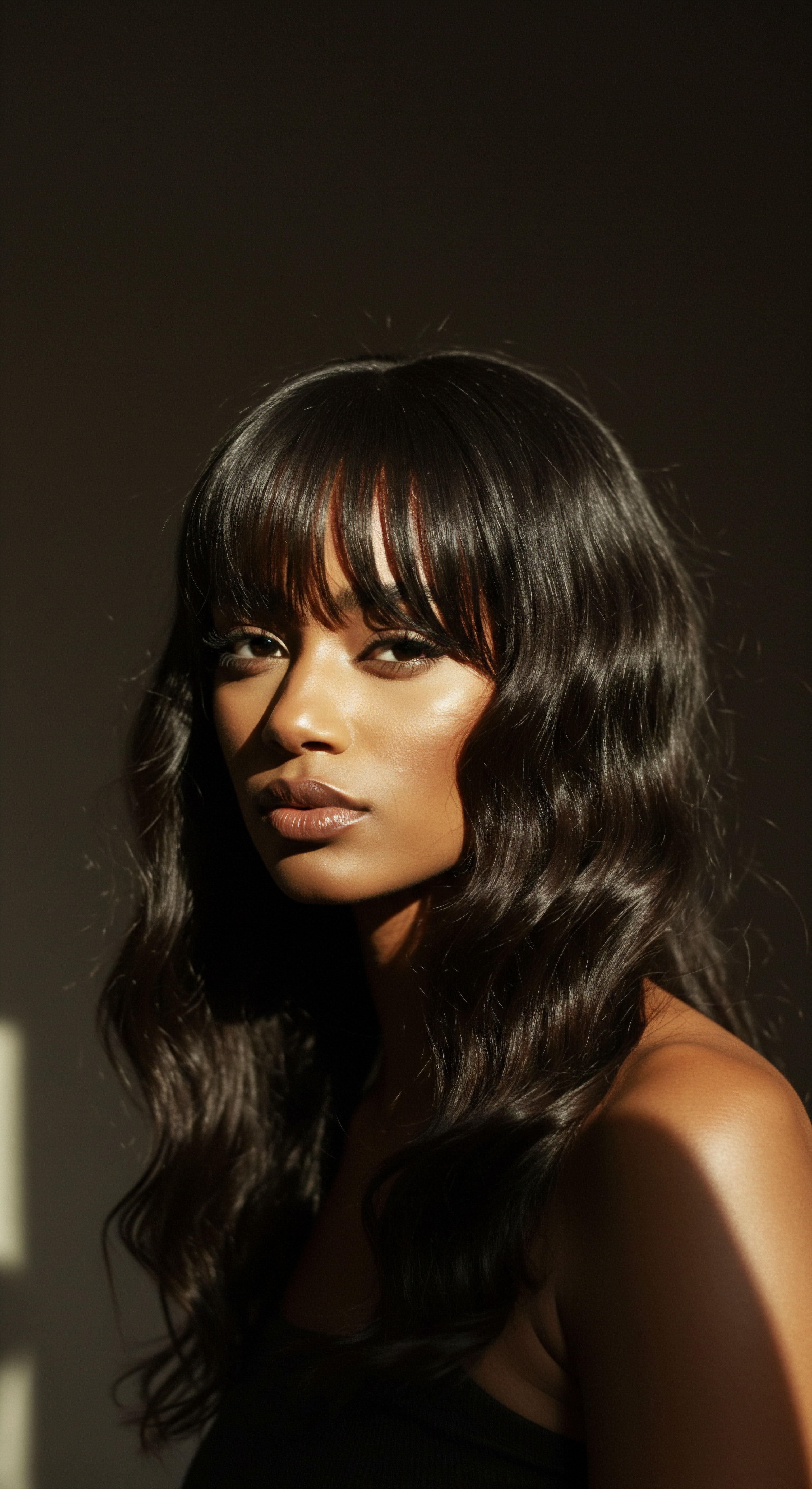
Roots
Consider for a moment the quiet strength residing within each strand, a story whispered through generations, shaped not only by ancestry but by the very air we breathe and the sun that warms our skin. Our hair, particularly textured hair, possesses an inherent capacity for connection, a delicate balance of structure and responsiveness. It is a living record, continually adapting to the world around it. This journey into understanding how environmental conditions can alter hair’s ability to retain moisture begins not with complex solutions, but with a deep, patient look at the hair itself, its fundamental makeup, and its quiet conversation with the atmosphere.

The Architecture of Hydration
At its very core, hair is a complex biological fiber, primarily composed of keratin, a protein. This protein is organized into distinct layers, each playing a role in the hair’s overall integrity and its capacity to hold water. The outermost layer, the Cuticle, resembles tiny, overlapping shingles on a roof. When these shingles lie flat, they create a smooth surface that reflects light and, crucially, seals in moisture.
Beneath the cuticle resides the Cortex, the hair’s innermost and most substantial layer. This is where the majority of hair’s strength, elasticity, and pigment reside. The cortex contains keratin bundles that can absorb and release water, influencing the hair’s flexibility and resilience. Some hair types also possess a central core, the Medulla, though its precise function in moisture retention is less understood.
The hair’s natural lipid layer, composed of fatty acids like 18-methyl eicosanoic acid (18-MEA), coats the cuticle, providing a vital hydrophobic barrier. This barrier helps to repel water and prevent excessive moisture loss, acting as a first line of defense against environmental aggressors. When this protective layer is compromised, hair becomes more hydrophilic, meaning it readily absorbs water, yet struggles to hold onto it, leading to dryness and vulnerability.

Porosity’s Whisper
The concept of Hair Porosity offers a lens through which to view how hair interacts with moisture. Porosity describes the hair’s ability to absorb and retain water, directly influenced by the state of its cuticle.
- Low Porosity Hair has tightly bound cuticle layers, making it more resistant to moisture absorption but also more effective at retaining it once absorbed. Products may sit on the surface, requiring gentle heat or steam to aid penetration.
- Normal Porosity Hair has cuticles that are neither too open nor too closed, allowing for a balanced exchange of moisture. This hair type generally responds well to most products and conditions.
- High Porosity Hair, often characterized by raised or damaged cuticle layers, readily absorbs water but struggles to hold onto it. This can result from genetic predispositions, as seen in some textured hair types where the natural twists cause cuticle lifting, or from external damage. Hair with high porosity may feel dry, appear frizzy, and break more easily because its internal moisture quickly escapes.
Hair’s intrinsic architecture, from its protective cuticle to its water-responsive cortex, sets the stage for how it engages with moisture from the world around it.

The Dance of Hygroscopy
Hair is a hygroscopic material, meaning it has a natural tendency to absorb moisture from the air. This property is fundamental to understanding how environmental humidity affects hair. In humid conditions, hair absorbs water from the atmosphere, causing it to swell. Conversely, in dry environments, hair releases its internal moisture to the drier air, leading to shrinkage.
This constant swelling and deswelling can place a strain on the hair fiber over time, impacting its elasticity. The very act of water molecules moving in and out of the hair influences its properties, highlighting the dynamic interplay between our strands and their surroundings.

Ritual
Our daily and weekly practices become a gentle conversation with our hair, a series of deliberate choices that acknowledge its unique needs in response to the environment. Understanding the foundational aspects of hair allows us to approach its care not as a battle against nature, but as a collaboration, a mindful ritual designed to honor its inherent beauty and fortify its moisture balance. This section moves beyond the ‘what’ of hair science to the ‘how’ of intentional care, guiding us through practical steps that can adapt to the shifting environmental landscape.

Adapting to the Air Around Us
The moisture content of the air, or humidity, plays a significant role in how our hair feels and behaves. This atmospheric moisture dictates how much water our hair will absorb or release.
- In Highly Humid Environments, hair absorbs moisture from the air, which can cause the hair shaft to swell. For textured hair, this often results in a loosening of curl patterns, increased frizz, and a feeling of heaviness. To manage this, the focus shifts to products that can create a barrier, sealing the cuticle to prevent excessive water absorption. Think of lighter leave-in conditioners and styling creams that offer definition without drawing in too much external moisture.
- In Dry Climates, whether from arid heat or cold winter air, hair tends to release its internal moisture to the environment, leading to dryness, brittleness, and a feeling of thirst. In such conditions, the care ritual centers on deep hydration and protective measures. Richer creams, butters, and oils become essential to replenish lost moisture and create a protective seal that minimizes further water loss.
Hair care rituals become a responsive dialogue with the environment, where product choices and techniques adjust to the prevailing atmospheric conditions.

Cleansing with Consideration
The very act of washing hair can impact its moisture retention. Hard water, prevalent in many regions, contains high concentrations of minerals such as calcium and magnesium. These minerals can bind to the hair surface, creating a film that impedes moisture and product penetration.
A 2020 study from The Journal of Cosmetic Science revealed that hair washed with hard water exhibited 25% less moisture compared to hair washed with soft water. This mineral buildup can lead to dryness, dullness, frizz, and even breakage over time.
To counter the effects of hard water, chelating shampoos, formulated with agents that bind to these minerals, can be incorporated into a routine. Installing a shower filter is another practical step that can reduce mineral deposits and allow hair products to work more effectively.

The Language of Products
Understanding product ingredients and their interaction with environmental conditions is a powerful tool in moisture management.
Consider the roles of:
- Humectants ❉ Ingredients like glycerin or hyaluronic acid draw moisture from the air into the hair. These are beneficial in moderately humid environments, but in very dry climates, they can sometimes draw moisture out of the hair if the air is drier than the hair itself.
- Emollients ❉ These soften and smooth the hair, often providing a light coating that aids in moisture retention. Fatty alcohols and natural oils like jojoba or argan are common emollients.
- Occlusives ❉ Ingredients such as heavier butters or certain oils create a physical barrier on the hair shaft, sealing in moisture and providing significant protection against environmental dryness. Shea butter and castor oil serve as excellent occlusives for textured hair.

Protective Styles and Gentle Handling
Protective styles, such as braids, twists, or buns, shield the hair from direct environmental exposure, minimizing moisture loss due to wind, sun, or dry air. These styles also reduce mechanical stress from daily manipulation, which can otherwise compromise the cuticle and lead to moisture escape.
Gentle handling, from detangling with a wide-tooth comb to avoiding harsh towels, helps preserve the cuticle’s integrity. When the cuticle remains smooth and closed, it acts as a more effective barrier against moisture loss, keeping the internal cortex hydrated and resilient.

Relay
Beyond the visible changes and daily practices, a deeper conversation unfolds between our hair and the surrounding world, one where the subtle forces of science, the whispers of cultural heritage, and the relentless march of environmental shifts converge. How do these unseen dynamics truly shape hair’s ability to hold moisture, moving beyond simple observation to a more profound understanding of the interconnectedness of our strands with the very fabric of existence? This section seeks to unravel these complexities, drawing upon research and broader contexts to illuminate the nuanced relationship between hair and its environment.

The Sun’s Silent Scorch and Air’s Unseen Assault
Solar radiation, particularly ultraviolet (UV) light, poses a significant threat to hair’s structural integrity and its capacity for hydration. UV rays can degrade keratin, the hair’s primary protein, leading to weakened strands and a compromised ability to retain moisture. This photodegradation extends to the hair’s lipid layer, further eroding its natural hydrophobic defenses.
A study by Croda Inc. highlighted hair’s susceptibility to UV damage, noting that UV radiation can destroy protein amino acids, leading to weakened hair structure, moisture loss, and dehydration.
Air pollution, a ubiquitous presence in many urban environments, also plays a role in hair dehydration. Particulate matter (PM2.5 and PM10) and various chemical gases can settle on hair and scalp, affecting proteins and disrupting the hair’s protective oil layer. This can lead to dryness, brittleness, and frizz. Oxidative stress, caused by pollutants generating reactive oxygen species, degrades keratin, making hair more susceptible to breakage and frizz.
Furthermore, the impact of solar radiation can be intensified by the presence of metals and pollutants on hair fibers, leading to an increased formation of reactive oxygen species and subsequent oxidation of hair structures. Research indicates that increased copper levels combined with UV exposure result in increased protein loss.
Hair’s capacity to retain moisture is profoundly shaped by the silent forces of UV radiation and atmospheric pollutants, both of which degrade its protective layers and structural proteins.

Humidity’s Double-Edged Nature
While humidity often receives blame for frizz, its relationship with hair moisture is complex. Hair, being hygroscopic, will absorb water from humid air, causing it to swell. For textured hair, this can sometimes lead to what is colloquially termed “hygral fatigue,” where repeated swelling and deswelling weakens the hair’s elasticity and compromises its cuticle. However, a critical examination of this concept reveals a nuanced perspective.
Some discussions within the scientific community suggest that the term “hygral fatigue” as applied to human hair, particularly regarding damage to curl patterns, might be a misinterpretation of research originally conducted on wool fibers. These studies on wool explored the effects of repeated wetting and drying on its mechanical properties, but direct parallels to human hair’s structural integrity under normal washing conditions are not always universally accepted as causing “fatigue” in the same damaging sense. Nonetheless, the principle that excessive and rapid changes in moisture content can stress the hair fiber remains a valid consideration for maintaining hair health.
Conversely, low humidity strips hair of its moisture, leading to dehydration, increased static electricity, and a propensity for breakage. The air’s dryness can cause the cuticle scales to lift, making it harder for hair to retain its internal hydration.

The Water We Wash With
The quality of water used for cleansing is another often-overlooked environmental factor. Hard water, laden with calcium and magnesium, forms mineral deposits on the hair shaft. This mineral buildup creates a physical barrier, preventing hair from fully absorbing conditioning agents and moisture.
A 2020 study in The Journal of Cosmetic Science found that hair washed with hard water had 25% less moisture than hair washed with soft water. These deposits can also lift the cuticle, leading to increased frizz and tangling, with a 2020 clinical study observing 30% more frizz in hard water-washed hair.
| Environmental Factor UV Radiation |
| Mechanism of Impact Degrades keratin proteins and lipid layers; generates free radicals. |
| Effect on Hair Moisture Retention Weakens hair structure, reduces hydrophobicity, causes moisture loss and dehydration. |
| Environmental Factor Air Pollution |
| Mechanism of Impact Particulate matter and chemicals settle on hair; cause oxidative stress; degrade keratin and protective oils. |
| Effect on Hair Moisture Retention Disrupts natural oil layer, leads to dryness, brittleness, frizz, and compromised protein structure. |
| Environmental Factor High Humidity |
| Mechanism of Impact Hair absorbs water, causing swelling. |
| Effect on Hair Moisture Retention Can lead to cuticle lifting and increased frizz; may stress hair with repeated swelling/deswelling. |
| Environmental Factor Low Humidity |
| Mechanism of Impact Hair releases internal moisture to dry air. |
| Effect on Hair Moisture Retention Results in dryness, brittleness, increased static, and lifted cuticles. |
| Environmental Factor Hard Water |
| Mechanism of Impact Mineral deposits (calcium, magnesium) coat hair. |
| Effect on Hair Moisture Retention Forms a barrier, impeding moisture absorption and product penetration; causes dryness, dullness, frizz. |

Evolutionary Whispers ❉ A Controversial Consideration
While often discussed in terms of aesthetics and care, the very structure of textured hair holds a deep connection to environmental adaptation. Research suggests that tightly curled hair, prevalent among individuals of African ancestry, evolved as a thermoregulatory adaptation in equatorial Africa. A study using a thermal manikin and human hair wigs found that tightly curled hair provided the most effective protection for the scalp against solar radiation, minimizing heat gain and the need for excessive sweating to stay cool. This protective function, allowing for efficient heat loss from the scalp while reducing direct sun exposure, would have been crucial for early humans, particularly as their brains grew larger and more vulnerable to heat.
This perspective introduces a thought-provoking idea ❉ the inherent characteristics of textured hair, which sometimes present moisture retention challenges in modern environments, may have originally served a vital protective purpose in ancestral climates. The density and curl pattern, while making it more prone to tangling and requiring specific moisture strategies today, were once a natural shield against intense solar radiation. This historical context underscores the idea that our hair’s interaction with its environment is not merely a contemporary concern but a legacy stretching back through time, a biological response to the elements.

Reflection
Our hair, a testament to heritage and individual expression, continuously dances with the world around it. The journey through its fundamental structure, the rituals we perform, and the intricate interplay with environmental forces reveals a profound truth ❉ moisture retention is not a static state but a dynamic conversation. By listening closely to our strands and understanding the subtle shifts in the air, the quality of our water, and the sun’s persistent presence, we can cultivate a deeper connection, offering our hair the thoughtful care it deserves, allowing its unique beauty to truly shine.

References
- Robbins, C. R. (2012). Chemical and Physical Behavior of Human Hair. Springer Science & Business Media.
- Bhushan, B. (2010). Biophysics of Hair. Springer.
- Marsh, J. (2007). The Science of Hair Care. CRC Press.
- Gavazzoni, M. (2018). Hair ❉ Its Structure and Response to Cosmetic Preparations. Clinics in Dermatology, 14(2), 105-113.
- Syed, A. N. (2002). Correlating Porosity to Tensile Strength. Cosmetics & Toiletries, 117(11), 57-62.
- Rele, A. S. & Mohile, R. B. (2003). Effect of Mineral Oil, Sunflower Oil, and Coconut Oil on Prevention of Hair Damage. Journal of Cosmetic Science, 54(2), 175-192.
- Wertz, P. W. & Downing, D. T. (1990). The Covalently Bound Fatty Acids of Human Hair. Journal of the Society of Cosmetic Chemists, 41(6), 349-354.
- Kalkbrenner, K. et al. (1990). The Effects of Ultraviolet Radiation on Hair. Journal of Cosmetic Science, 41(6), 377-386.
- Jablonski, N. G. & Chaplin, G. (2014). The Evolution of Skin Pigmentation and Hair Texture in People of African Ancestry. Dermatologic Clinics, 32(2), 113-121.
- Lasisi, T. et al. (2023). Human Scalp Hair as a Thermoregulatory Adaptation. Proceedings of the National Academy of Sciences, 120(24), e2300421120.